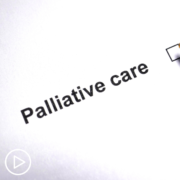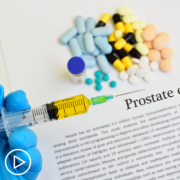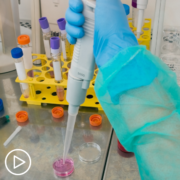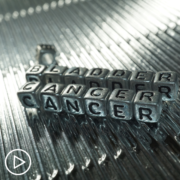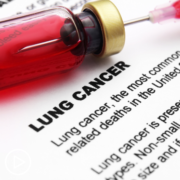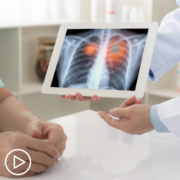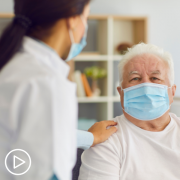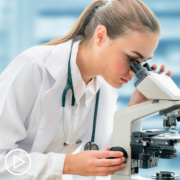Exciting Advances in Waldenström Macroglobulinemia (WM) Treatment
Exciting Advances in Waldenström Macroglobulinemia (WM) Treatment from Patient Empowerment Network on Vimeo.
What new therapies are on the horizon for patients with Waldenström macroglobulinemia (WM)? Dr. Shayna Sarosiek from Dana-Farber Cancer Institute reviews promising developments in WM treatment, including immunotherapy and BTK inhibitors.
Dr. Shayna Sarosiek is a hematologist and oncologist at the Dana-Farber Cancer Institute where she cares for Waldenström macroglobulinemia (WM) patients at the Bing Center for Waldenstrom’s. Dr. Sarsosiek is also Assistant Professor of Medicine at Harvard Medical School. Learn more about Dr. Sarosiek, here.
See More From The Pro-Active Waldenström Macroglobulinemia Patient Toolkit
Related Programs:

|

What Are the Treatment Goals for Waldenström Macroglobulinemia? |

|
Transcript:
Katherine:
What are you excited about when it comes to Waldenstrom’s research?
Dr. Sarosiek:
So, there a couple of things that I find really exciting right now. One thing in particular is currently for treatment for Waldenstrom’s, we often use BTK inhibitors. So, the group of medications that includes zanubrutinib (Brukinsa), ibrutinib (Imbruvica), acalabrutinib (Calquence). And that class of medications has really revolutionized treatment for Waldenstrom’s. But sometimes patients become resistant to those medications. And there’s a new group in that same class of what’s called BTK inhibitors.
And those are non-covalent BTK inhibitors. And those drugs actually work often for patients who progress on initial therapy with ibrutinib or zanubrutinib. So that really, I think is game changing. There are some early Non-Covalent BTK inhibitors that are in trials. And I really think it’s going to lead to use of those medications very commonly in the future for Waldenstrom’s. So, that I think is exciting to have a next oral therapy to go to after progression on the current therapies. I’m also excited about new combinations that are being tried in Waldenstrom’s.
So, using combinations of different oral therapies together that would offer deep responses and also offer a time-limited therapy. Because right now many of our treatments are given indefinitely. And so, offering a limited therapy. So, I think that, and there are many other things I could go on for a long time about this. But there are many things that I think are really exciting and we’re going to be changing the field in the coming years.
Katherine:
Dr. Sarosiek, what is immunotherapy? Could you define that and also, how does it work to treat Waldenstrom’s?
Dr. Sarosiek:
So, immunotherapy includes many different types of medications. But these are all medications that either use the patient’s immune system or use something from the immune system, like an antibody to help fight off a cancer. And this plays a huge role currently and I think it will continue to in the future. So, probably the most common immunotherapy that patients are familiar with, with Waldenstrom’s now is rituximab (Rituxan). So, that’s a monoclonal antibody.
And that’s used in many combinations in Waldenstrom’s and is a very important therapy currently. And that antibody is essentially just goes into where the cancer cells are located and attacks that type of cell.
But the other immunotherapies that are up and coming – which I think are important for patients to know about – one is CAR-T cell therapy. So, a lot of patients ask me about that. and that’s essentially, a T cell is part of the immune system that every patient has. And what CAR T-cell therapies do is patients can collect from their bloodstream – the physicians can collect T cells and then they modify those T-cells in a way so that they’ll recognized the cancer and attack the cancer.
And so then, those T cells are given back to the patient and then that T cell can go and work with the patient’s immune system to destroy the cancer. And that’s been very successful in a lot of other cancers and is being used in Waldenstrom’s now. And I think we’re going to be learning a lot about that and it’s going to be an important part of the future with immunotherapy involved in Waldenstrom’s. Another therapy similar is something called BiTE therapies. So, Bispecific T-cell engagers.
So, that’s essentially two antibodies together. One antibody kind of pulls in the cancer cell and one antibody pulls in the immune system. So, when that treatment is given to patients it kind of brings the immune system close to the cancer cells. So, your own immune system can help fight off the cancer. So, those are just kind of two of the newer immunotherapies that are up and coming that I think will play an important role in the future in this disease.
Katherine:
Who is this treatment right for?
Dr. Sarosiek:
Immunotherapies in general currently we’re using them – currently immunotherapies are being used in patients who have had a relapsed disease. So, they have already had current available therapies, like BTK inhibitors or rituximab. And there are clinical trials that can use CAR-T cell therapy. And there are up and coming trials with BITE therapy. So, right now it’s being used in their relapse setting. But as we learn more about it, it’s possible those we moved earlier on to patients who are earlier in their disease course.
Katherine:
What kind of side effects should patients be aware of?
Dr. Sarosiek:
So, the side effects can vary depending on what the therapy is. So, patients who are getting rituximab, the currently available immunotherapy, patients can have infusion reactions. So, as your body is kind of getting used to that monoclonal antibody coming in, you can have a reaction. And in that case, we have to stop the infusion, wait for the side effects to settle down, and then restart.
Katherine:
What type of side effects would they be?
Dr. Sarosiek:
So, side effects from rituximab infusions can really vary. In some patients it can be similar to an allergic reaction. So, let’s say itchy throat or a rash or hives. Sometimes it can be pain in the chest or the back or trouble breathing. So, they can really vary. But most of the time, those can – when the infusion is stopped, we can give patients medications like Benadryl or Tylenol to help with symptoms. And then we can restart the Rituximab at a lower rate. And that lower rate allows the patient’s body to kind of get used to the medication and continue on the treatment. So that’s generally the things we watch for with Rituximab.



